
Sarala Thulasi Palpanadan, Iqbal Ahmad, Venosha K. Ravana
http://www.iaeme.com/IJMET/index.asp 809 editor@iaeme.com
1. INTRODUCTION
The two areas of English language and technology are inseparable where they complement
each other very much. Having a good grasp of English language and technology skills
facilitate the learning skills to obtain more knowledge (Ahmadi, 2018). English is becoming
popular day by day all over the world including the technology field. It is used as an
international lingua franca (Ahmad, 2016). English is an important language to have better job
employment opportunities in all fields (Suryasa et al., 2017; Swales & Feak, 2004). Thus,
mastering English in our daily life has become essential (How et al., 2015; McKay, 2002).
Meanwhile, technology also plays a crucial role in bringing about changes in people’s
perception, association and style of lives (Salehan, Kim & Lee, 2018). Technology is a tool
utilized by everyone, especially engineers to uphold the development and improvement of the
world so that everyone can benefit from it. Technological determinism theory (TDT) supports
the idea that the development of a nation based on its societal and cultural values depend on
its progression of technology (Howells, 1997). Thus, it is very important to study the
challenges of English instruction in technology integrated courses among the Malaysian
undergraduates who are pursuing technology and engineering based courses at the
universities.
Malaysia is a multi-race country and Malay is the national language. Malay language is
often used as the language of instruction, administration and employment in government and
non-government sectors (Mahir et al., 2007). Malay is the language that is used most
frequently for communication among people who are not proficient in English in the
Malaysian context. English is usually used for some specific occasions and events at English
Departments in government institutions and some private sectors. As a matter of fact, many
Malaysians still use Malay widely in their daily communication without having to worry
about their incompetency in English as it is easily understood by the majority.
Apparently, the Malaysian education system has promoted bilingualism and
multilingualism school system with three different mediums as instruction, such as Malay,
Tamil and Mandarin language mediums. This is to let Malaysians to have a chance to learn
their own mother tongue according to their own races (Benraghda et al., 2017). Various
languages have benefits for Malaysian students and allow them to get further understanding
about the importance of English language (How et al., 2017). However, as English is still not
widely used in Malaysia, this might affect the mind sets of the people that English language is
not the most important language and therefore, they need not focus in using English in their
daily lives (Heriansyah, 2012; Pandian, 2002). Consequently, people may gradually ignore
the importance of English language in their daily activities. This is a very serious matter that
has to be investigated and discussed as many graduates scored good grades in the examination
but they tend to face difficulties in finding jobs due to the lack of fluency in English language
(Kirkpatrick, 2012; Nunan, 2003). Employers claim that the graduates’ lack of
communication skills was one of the reasons of the increasing unemployment rate in Malaysia
(Shanmugam, 2017). In addition, high unemployment rate among Malaysia graduates in the
private sector is often attributed to lack of English proficiency and communication skills
(Ting et al., 2017).
In order to ensure that people can communicate well in English language, several
continuous processes need to be involved in their daily routine (Rashid & Hashim, 2008;
Thirusanku & Yunus, 2014). Effective communication and understanding are among the
important processes that are involved in peoples’ daily lives which can lead to good grasp of
English. In addition, university students and the surrounding community should consciously
work towards improving the ability to speak in English fluently. Therefore, this research was
carried out at UTHM to determine the reasons that deter effective English communication































